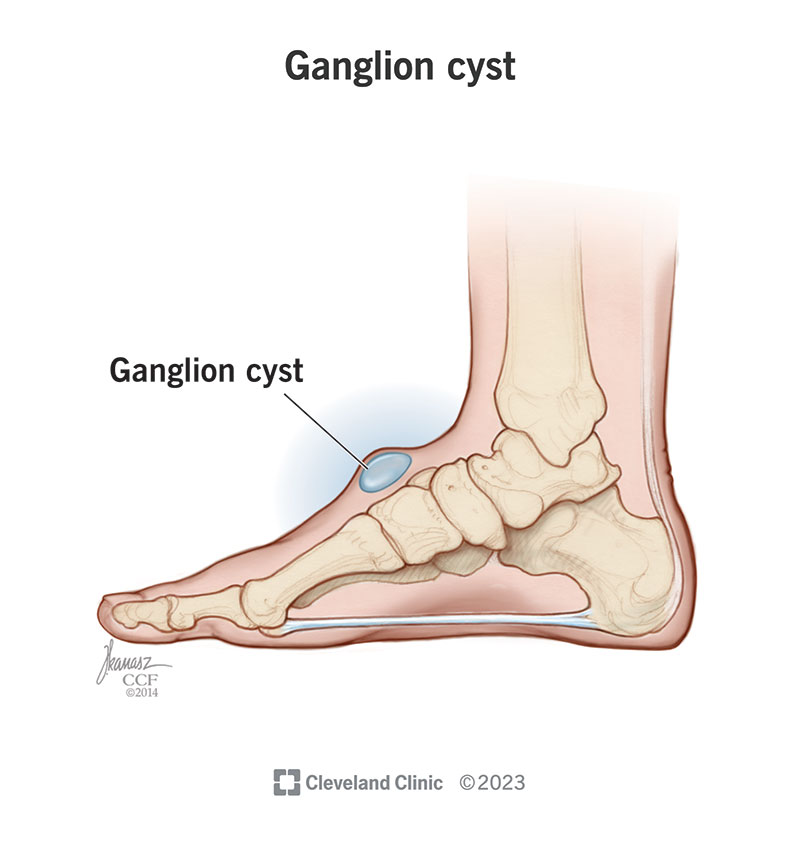A ganglion cyst (bible cyst) is a fluid-filled lump below the surface of your skin that appears on or near joints and tendons. They usually don’t cause any symptoms and often disappear on their own. Treatment ranges from observation to outpatient surgery (ganglionectomy).
Advertisement
Cleveland Clinic is a non-profit academic medical center. Advertising on our site helps support our mission. We do not endorse non-Cleveland Clinic products or services. Policy

A ganglion cyst (plural: ganglia) is a small, fluid-filled lump just below your skin. This type of cyst can develop when you have a tear in the tissue that covers a tendon or joint. This causes the tissue to bulge and create a sac. Another name for a ganglion cyst is a bible cyst.
Advertisement
Cleveland Clinic is a non-profit academic medical center. Advertising on our site helps support our mission. We do not endorse non-Cleveland Clinic products or services. Policy
Ganglia often appear at specific joints. Moving the joint near the cyst may increase swelling and worsen any discomfort you feel. But ganglia aren’t cancerous and are usually harmless. Ganglion cysts typically develop on your:
Some ganglion (pronounced “gang-glee-uhn”) cysts are so small that you may not see an obvious lump under your skin, but they still cause pain. They are known as occult ganglions. Your healthcare provider may order a magnetic resonance imaging (MRI) test or an ultrasound to reveal them.
Many people get ganglion cysts. Bible cysts are some of the most common benign (noncancerous) masses that develop in your body’s soft tissues.
A bump beneath your skin is the main sign of a ganglion cyst. This bump can vary in size and shape. It may grow larger over time or when you move that area (joint) more. The cyst may not bother you at all. If you do have symptoms, you may notice some muscle pain or a tingling sensation. This is usually mass effect, which means that the mass is causing pressure and may cause inflammation.
Advertisement
Bible cysts are usually (but not always) firm to the touch. Some people report that the fluid-filled cysts are soft. The lump likely moves easily under your skin.
A ganglion cyst usually looks like a lump or bump on your wrist, finger or foot. This lump may look symmetrical (round) or misshapen (more like an oval).
A ganglion cyst sits just below your skin’s surface. It may look like a bubble blown from a joint. Ganglia sometimes have a translucent effect (you can see through the lump at certain angles).
No one knows exactly what causes a ganglion cyst to start growing. Some theories indicate that a cyst may develop after an injury to a joint or tendon, which allows tissue to leak or bulge out.
Anyone can get a ganglion cyst. But certain factors may increase your chances of having one of these cysts:
Healthcare providers usually diagnose bible cysts by performing a physical exam. A lump’s appearance and location (such as on your wrist or fingers) are telltale signs of ganglia. Your provider may press on the bump to see if it bothers you. Or they may shine a light on the lump to see if it’s translucent (partly see-through). Your provider may recommend an X-ray to look for underlying joint arthritis near the cyst.
In some cases, your provider may remove a sample from inside the lump (called a biopsy) for further analysis. Ganglia usually contain a jelly-like fluid, not solid tissue.
Ganglion cyst treatments include:
Your provider may consider surgery if other treatments don’t provide relief or your cyst comes back. Surgeons treat ganglia by removing the entire cyst. A cyst often includes a stalk-like structure (root) attached to the cyst.
Advertisement
Your surgeon may use open (traditional) techniques or arthroscopy (tiny incisions). In some cases, surgeons may take some tissue from the nearby joint to fully repair the issue.
Ganglion cyst removal surgery is called ganglionectomy. It’s usually an outpatient procedure. That means you should get to go home the day of surgery. Full recovery takes two to six weeks. Orthopaedic surgeons receive specialized training to perform intricate procedures on your body’s joints and other soft tissues.
Surgery may effectively resolve your symptoms. Having a bible cyst surgically removed greatly reduces the risk of a cyst coming back. Still, ganglia come back after surgery in an estimated 5% to 15% of cases.
If a ganglion cyst doesn’t bother you, it might not need treatment. Sometimes, a ganglion cyst goes away on its own.
Your provider may recommend treatment if a ganglion cyst:
Ganglion cysts aren’t dangerous. They are benign masses, which means they won’t spread to other areas. Ganglion cysts aren’t cancer.
Advertisement
While some ganglion cysts may be painful, they pose no serious threat to your health.
You can’t prevent a ganglion cyst. Medical experts don’t know what causes them to develop.
If you have a ganglion cyst, you may want to ask your healthcare provider:
If you have a ganglion cyst — a fluid-filled lump below the surface of your skin — you may not need treatment right away. If the lump doesn’t bother you, your provider may follow you over time to check for any concerning changes. Ganglion cysts are benign, which means these lumps aren’t cancer. They pose no long-term threat to your health. Many ganglion cysts go away on their own. If a ganglion cyst affects your quality of life in any way, ask your provider about treatment options. Splints, over-the-counter pain medication or surgery may provide relief.
Advertisement
Cleveland Clinic’s primary care providers offer lifelong medical care. From sinus infections and high blood pressure to preventive screening, we’re here for you.

Last reviewed on 12/22/2023.
Learn more about the Health Library and our editorial process.